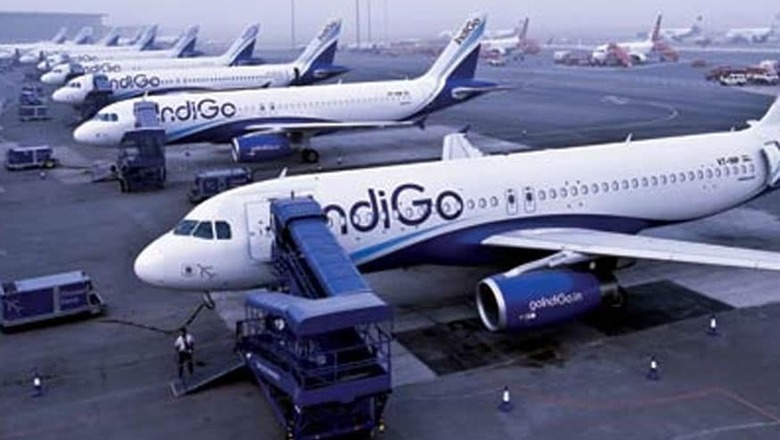
views
New Delhi: The ugly spat between the two promoters of IndiGo couldn’t have come at a worse time. The Indian aviation market is in a sweet spot, with consolidation after the demise of Jet Airways boosting the prospects of all remaining players and projections of robust overall growth for the next five years. Why would the market leader want to get distracted now, instead of moving quickly on its competitive advantage?
Rakesh Gangwal and Rahul Bhatia own nearly equal stakes in the airline and together account for 75% of IndiGo’s total shareholding. Gangwal has written to SEBI asking for a probe into what are known as ‘Related Party Transactions’ by Bhatia — where businesses outside IndiGo, which are owned by Bhatia, provide some services to the airline for a fee. As SEBI initiates a probe into the shareholder agreement and other pacts which grant Bhatia more powers than Gangwal to make certain decisions, the IndiGo scrip has already plunged on the bourses.
IndiGo is the market leader of India’s storied domestic aviation, accounting for almost 40% passenger share and operating the largest fleet of aircraft. Not only is its future growth likely to now be in a shadow till the promoter issues are sorted out, the unpleasantness has come just after another stalwart, Jet, has been grounded. This has thrown up unprecedented growth opportunities for the remaining players.
Some numbers should demonstrate why this is a happy phase for Indian airlines. An analysis by Goldman Sachs shows that India is already the third largest aviation market globally and is expected to double in size by 2023 or in the next five years. This means continued rapid growth in passengers, which should cheer all airlines. And with the demise of Jet Airways, which was second largest by passengers after IndiGo, there are obviously attractive opportunities in the market for all the remaining players.
Why Indian airlines probably never had it so good is also clear from what analysts at brokerage Edelweiss have said. Profits are likely to continue to surge in the June quarter across the aviation sector with earnings rising multi-fold.
“While Indigo is estimated to continue to clock steady 25% passenger growth year on year, bolstered by international operations, SpiceJet’s passenger growth is likely to surge to 25% due to addition of Jet Airways’ 30 737-NG to its fleet. Indigo’s yields are likely to rise 10% year on year due to surge in fares on routes vacated by Jet during April. SpiceJet’s yield growth is likely to be lower at 5% as it was unable to deploy capacity on Jet routes due to 737 Max grounding”. Yield is defined as revenue per passenger.
Besides a healthy growth in passengers and revenue from each due to the demise of Jet, Indian airlines have also been reaping the benefits of benign oil prices. The Edelweiss analysts noted that ATF (aviation turbine fuel) prices are down 1% year on year, adding further fuel to profits. Passenger load factor (percentage of occupied seats on a plane) are estimated to remain steady at 89.4% and 93.3% at Indigo and SpiceJet for the June quarter as capacity additions will broadly match passenger growth, the analysts have said.
In other words, almost 9 in 10 seats on offer from IndiGo and SpiceJet would have been paid-for in the June quarter and their revenue from each passenger also increased.
That the Indian market is poised for a further big leap is also clear from what Goldman analysts have said. “Indian carriers with fleet strength of 681 aircraft as of March 2019 have outstanding orders for 692 planes to be delivered over the next few years. With demand expected to remain strong, this should keep load factors high (in the 87-90% range) and demand-supply balanced.”
With such bright prospects for growth, should IndiGo now get distracted with related party transactions and a battle for control?
Already, analysts have noted that SpiceJet has been nicely ahead of IndiGo in pickings after Jet’s demise. Brokerage Elara Securities said that almost half of the airport slots of Jet have been farmed out at India’s two busiest airports (Delhi and Mumbai) and SpiceJet has bagged the largest number (276) followed by IndiGo (189). The analysts have gone on to say that SpiceJet’s market share will rise by 6% while that of IndiGo will increase by 5% due to new slots at busy airports. SpiceJet is then obviously the biggest beneficiary of Jet’s demise, IndiGo needs to buckle up.
The Edelweiss analysts have warned of promoter spat impacting IndiGo’s “currently strong franchise”. They have said current valuations reflect high growth expectations in an industry characterised by low barriers and innumerable past failures. “We believe, scenarios range from ‘not good’ to ‘ugly’. While we do not perceive immediate risk to earnings, we believe the market is sensitive to governance issues.”
The “not good” scenario is a near-term overhang which blows over but chances of a quick and amicable solution seem remote. “Ugly” scenario means a prolonged battle between promoters, which could raise serious questions on governance. And if either co-promoter were to sell out, it could result in a significant overhang on the stock.
It would be IndiGo’s interest to quickly sort out the promoter mess and move steadily to grab more of the expanding Indian aviation pie.(The author is a senior journalist. Views expressed are personal)



















Comments
0 comment